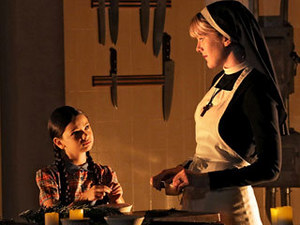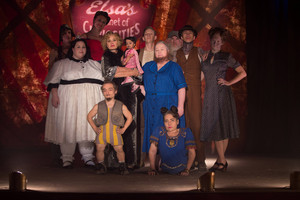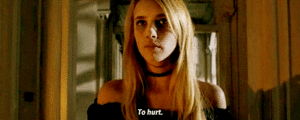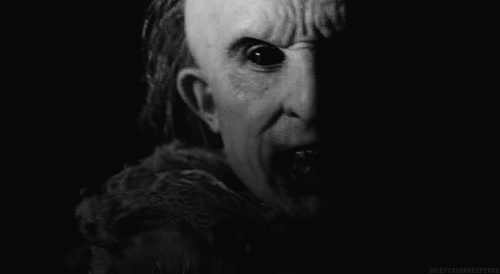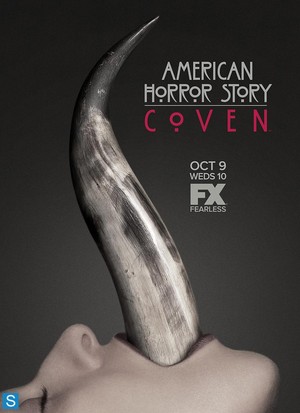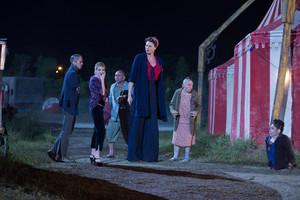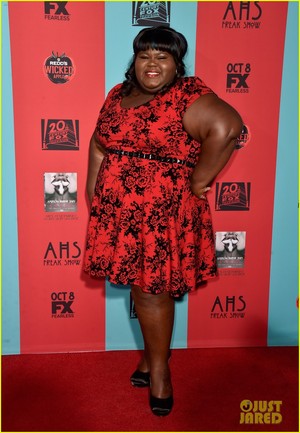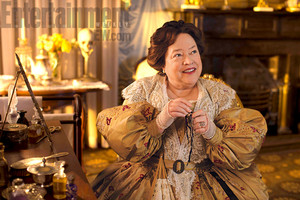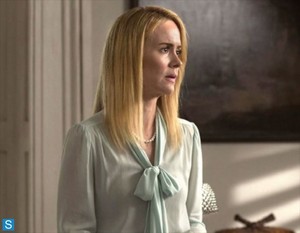Episode 06 | Aired Nov 21, 2012
Sister Mary and assorted Briarcliff devils reveal their "Origins Of Monstrosity" in a very special Thanksgiving episode. (Not!)
By Jeff Jensen at EW.com
The problem of evil is a tricky little devil. There is no single or simple answer to explain wickedness. But that doesn't mean we shouldn't ask and explore the question. ("If a way to the better there be, it lies in taking a full look at the worst" – Thomas Hardy.) Indeed, Ernest Becker – the famed cultural anthropologist who wrote The Denial of Death and Escape From Evil – believed that the root of humanity’s inhumanity to man lies in running away from the awareness of the only thing any of us know for certain: That we’re all going die. “It is the disguise of panic that makes us live ugliness,” wrote Becker. In this way, the problem of evil is made even trickier: We make the whole damn thing much more complicated than it needs to be. You know: Just like these recaps. But good news! This week’s gross indulgence is 2000 words shorter than usual, as I have a turkey to cook. (I plan to use a little nutmeg this year. I understand it makes a difference.) The bad news? There’s a long paragraph about monkey depression coming up, as well as a plethora of poorly applied references culled from the works of Alice Miller and Adrienne Rich. Just be thankful I decided to cut the digression on the mythology of adult breast feeding! Didn’t want to ruin your appetite. Gobble-Gobble!
The monsters of “The Origins Of Monstrosity” – Oliver Thredson/Bloody Face, Dr. Arthur Arden/Hans Gruber, Sister Mary Santanica, Problem Child Jenny -- had several things in common, besides being two-faced deceivers. For starters, they didn't think they were monsters. They viewed themselves as heroes engaged in great, grandiose projects full of significance and purpose. They claimed to be “self-aware” or “enlightened.” They felt unloved, unacknowledged, and untouchable, and they had each developed sick schemes to feel otherwise. They believed they were beyond good and evil, and they believed same thing about their victims: They brought it on themselves.
Regardless of their individual nature, each of the episode's so-called monsters became monstrous, or remained so, from a lack of proper nurturing, be it from parents, peers, society, even God… if God even exists. (Satanically-enhanced Sister Mary claimed He didn’t, but the devil always lies. Right?) In fact, the story seemed to argue that, like sexuality, human beings are fundamentally wired for nurturing. In a digression after my own heart, Dr. Thredson cited the work of psychologist Harry Harlow, who (according to Wikipedia) “demonstrated the importance of care-giving and companionship in social and cognitive development.” Thredson referred to Dr. Harlow’s experiments with baby rhesus monkeys. They were separated from their mothers after birth and given substitute mothers, one made of wire mesh (with milk) and one covered with cloth. Every monkey preferred the cloth-covered surrogate, said Thredson, because of the simulation of skin, and the touch of similar beings. What Thredson couldn’t tell us – because historically, this hadn’t happened yet -- was that Dr. Harlow’s later research, conducted during the 1970s and widely condemned, involved placing infant monkeys in cages uniquely designed to cultivate clinical depression. The technical term for the environments was “a vertical chamber apparatus.” But Dr. Harlow preferred more descriptive terms, including “a dungeon of despair.” Looking at these cages, I couldn't help but project upon them the design of Briarcliff Manor Sanatorium, itself a vertically designed structure with its own “dungeon of despair” operated by a scientist chasing after remedies for the human condition. Because Briarcliff is also a metaphor for culture, we wonder: Is our society a virtual “dungeon of despair,” a habitat for inhumanity that cultivates depressed, demented, doomed monkey-people? Are we responsible for the monstrosity in our midst? Or did I just go and make stuff more complicated again?
(Monkey-people!)
"Our heroic projects that are aimed at destroying evil have the paradoxical effect of bringing more evil into the world. Human conflicts are life and death struggles -- my gods against your gods, my immortality project against your immortality project. The root of humanly caused evil is not man's animal nature, not territorial aggression, or innate selfishness, but our need to gain self-esteem, deny our mortality, and achieve a heroic self-image. Our desire for the best is the cause of the worst." – Sam Keen, from the introduction to The Denial of Death
Suffer The Betrayed Child. The terrible tale of one sinister girl encapsulated many of the episode's thoughts on "The Origins Of Monstrosity." Jenny Reynolds was an odd lass with an adult air and chillingly detached manner who claimed that a bearded man in a brown coat murdered the only girl who would play with her with a pair of scissors under the bridge, down by the river. The cops believed her, because why wouldn’t they? She’s a little girl! And all little girls are such Heavenly Creatures, aren’t they?
But Jenny’s mom suspected differently. Especially after she found the murdered playmate's snipped-off pony tail in Jenny’s pocket. Mother Reynolds didn’t have the heart or guts to turn Jenny over to the police. (Mistake number one…) But she had enough sense to know that something was seriously wrong with Jenny, and so she took her problem child to Briarcliff Manor Sanatorium for fixing. (… and mistake number two.) Sister Jude – back in the habit after last week’s relapse into Trampy Judyness; still employed as Monsignor Timothy’s faithful right hand (but not for long) – wanted to help. She really did. “One of my dreams, for Briarcliff, was to open a children’s ward,” she said. “There are so many little souls that could use our help.” Her inspiration, no doubt, was that drunken night long ago when she failed another little girl in crisis. (SCREECH! SLAM! SPLAT!) Instead, all Sister Jude could do was supply Jenny’s mom with Briarcliff’s take-home miracle cure: The Bible. “Prayer,” she said, “is your strength and your ally.”
But Mother Reynolds wasn’t going to take “No” for an answer, and so she kissed her daughter on the forehead and ran like a bat out of hell, abandoning Jenny to Briarcliff. What to make of this profound, painful parental betrayal? 1. She just couldn’t accept personal responsibility for her child (although in her defense, she blamed herself, wrongly, for Jenny’s alleged abnormality for years prior this); or 2. She believed that Briarcliff had a moral responsibility to help her. It’s probably more (1) than (2), but (2) is more interesting to think about, given Briarcliff is a metaphor for society/culture, and one of the essential themes of American Horror Story is society/culture’s responsibility to the individual human flourishing. From this perspective, The Asylum's response to Jenny was rather provocative…
The Untouched McKee. As Sister Jude scrambled to track down Mother Reynolds and make her come back and take her kid, Jenny fell to the care of Satanically-enhanced Sister Mary, who knew that the creepy lass was psycho. “I know everything,” said the nun, chopping onions with a Batesy cleaver. “I’m a devil.” But Sister Mary told Jenny she should feel no shame. After all: Her "friend" deserved it. “She was a phony little s—t! She didn't even like you! She just played with you because her mother told her to!” Yep: Ouch! Except Sister Mary's tough love tactlessness didn’t seem to ruffle the gloomy little sociopath. “But you’re lucky. Because you were born with the gift of authentic impulse," said Sister Mary, using a philosophical buzz word that links to Sartre's Being And Nothingness and notion of " Bad Faith," the idea that people blindly adopt values and roles foisted on them or engendered by their culture, at the cost of their true identity. "I wasted so much time trying to be a good girl," said Sister Mary. "All I wanted, in the whole world, was for people to like me…”
We then got Mary Eunice McKee’s origin story – a moment from her adolescence that forged or at least summed up her worldview. She was a shy girl – an outsider; a misfit; “just everyone’s victim.” Her luck seemed to change one day when the popular kids invited her to a skinny dipping pool party. She was “the guest of honor,” she was told, and she was shown to the diving board by the host, a certifiable Mean Girl. But when it came time for everyone to drop their social roles and reveal their authentic selves bathrobes, Mary realized she had been duped: Everyone else was wearing a bathing suit. She stood there, naked and exposed and ashamed, everyone looking and laughing at her. And then the Swim Party Carrie used her telekinetic powers to burn everyone alive! No: She escaped by jumping into the pool…
And then, eventually, into The Church. “The only place I thought I would be safe was with God,” she said. “You know there’s no God, right? You’ve already figured out that it’s just a bunch of crap someone made up to keep you from being who you are. From doing what you really want to do. What a chump. And look where it got me? Right here, taking a s—t from a mean old bitch who drinks… and wears trashy red lingerie under her habit.” (Sister Mary made Sister Jude sound pathetic, though later, in one of the episode’s best scenes, we learned just what Judy's power color undies meant to the one-time victim-chump.) For the first time, Jenny laughed. Feeling comfy with the naughty nun, Little Miss Sinister sweated the prospect of being locked in her room forever, prohibited and inhibited from pursuing her bliss. “Don't be a whiner. You're smarter than they are. Don't you ever forget it,” said Sister Mary, running a finger along the dull end of her chopping knife. “Maybe you just need to learn to defend yourself…”
The Lingering Effects Of Hurtful Parenting. Eventually, Mother Reynolds was made to return and retrieve the undesirable misfit daughter she tried to save/dump at Briarcliff. She also suffered the consequences of her dubious parenting, as did Jenny’s allegedly “normal” siblings. In the epilogue, we saw that Jenny had embraced Sister Mary’s unique brand of existential self-help philosophy – How To Find Happiness In A Godless And Nauseating Universe Where No One But You Cares About You – by obeying her authentic impulse, by following her bliss, by… killing her mother and her brother and sister with a butcher knife, under the bridge down by the river. It was the bad man with the beard and brown coat again, she told the police. And they believed her. Which was kind of hard to believe. But hey: Metaphor! Behold the latest cultural product to roll out of the Briarcliff monster-making factory: The Emotionally Untouchable Ayn Rand Ubermenchick! (But at least she’s well prepared for Joss Whedon’s zombie apocalypse…)
The Drama Of The Untouched Child. Oliver Thredson just wants to be loved. Is that so wrong? Well, when you’re abducting women and slicing off their flesh, then yes. His motive: Getting what he was denied as a child: the touch, the tangible feel of a mother’s love. He told his origin story to Lana Winters while sitting on a big old bed eating tomato soup and croque monsieur (“Can I tell you a secret? A little nutmeg makes all the difference in the world.”), just two giddy-giggly pals sharing secrets during a sleepover… except Lana was a hostage, a woman in chains. She spent most of the episode trying very hard to keep her wits and navigate Oliver’s twisty-twisted persona while simultaneously struggling to keep at bay the Kong-sized terror that wanted to stream out of her unblinking bloodshot eyes and tear out of her throat with a Fay Wray scream. (I'm more of a Jessica Lange man myself.)
Thredson’s evolution into Bloody Face began when his mom abandoned him at an age before memory. He grew up in an orphanage – “in the system,” he said with a dismissive eyeroll – where he had morality beaten into him with a leather crop, where all of his basic needs were met, except the spiritual/emotional ones no institution can satisfy. “I followed all the rules,” he said, “especially the rules against affection, or any unnecessary bodily contact, because touch would certainly spoil the child.” In a moment shot topsy-turvy, the camera framed Thredson and Winters upside down on the bed, then glided into a slightly more conventional overhead establishing shot as Thredson claimed to be more “self-aware” than his peers, “different” from other kids, and acutely aware that he was “afflicted.” He wanted to study psychiatry, so he could better understand his “disorder.” The self-conscious camera expressed Thredson’s oddball sense of self... but the disorientation also suggested, to me at least, that for all his claims to enlightenment, the dude was delusion, nonetheless. A turning point in his life came at medical school, where the other students clearly viewed him as a misfit. Gay? Possibly. Depends on how you interpreted this line from a snarky classmate: “Hey, Thredson! I heard this is the closest you’ll get to a girlfriend this quarter!” The jerk was referring to the cadaver of a 33-year-old woman. “The same age as my mother when she abandoned me,” he said. “The same age as you, Lana.” He imagined the woman was his mother, and during one dark night, alone with the body, transgression ensued...
Thredson stripped to the waist and cuddled with the dead woman. At last! A mother’s touch. Skin to skin contact. Just when we thought that necrophilia might follow... oh, wait, was that just me? Forget I said that! Anyway: Didn't happen! “Oh, but she smelled of formaldehyde,” he recalled. “And her skin, even after I removed it, was cold and stiff.” So Thredson began abducting and killing, skinning and decapitating. “Warm living skin,” he murmured. Lana didn't like the sound of that, and she started to lose it, but Thredson quickly comforted her and told her not to worry: “Now that you’re here, all of that work is behind me. Mommy.” Lana gulped.
Turned out Thredson realized that he had deeper spiritual cravings that mere Filet-o-Female couldn’t sate. He needed to be known. By another human being who would not judge him, who would give him grace to be his freaky self, who would love him unconditionally. He also yearned for significance -- esteem and acknowledgment from the world. He believed Lana was uniquely qualified to satisfy all of those longings, and he came to that conclusion before their Briarcliff daze. Flashback! On the day of Kit Walker’s arrest, Thredson went to the police station to watch the spectacle and found himself within earshot of an earnest young reporter, an Upton Sinclair wannabe determined to get the scoop on Bloody Face: None other than Lana Winters. “Aren’t you sick and tired of writing the same old story with different names?” she told a fellow journalist, a man named Phil. “Start with some blood and guts, a pinch of sympathy for the victims, then top it off with moral outrage.” Did she think a “woman’s touch” would make a for a better story? Hell yes! “That’s what's been missing from this story. You think this mook is just some monster, but no monster starts off that way. He was somebody’s precious baby crying out for his mommy.” From the shadows, Thredson listened, and he swooned. Mommy. A plan bloomed. Lana Winters, imbued with such profound empathy, would be his Truman Capote. She would grok him, then share his story in print... followed by a book, then a feature film adaptation, and a host of other media opportunities, no doubt.
The Struggle Against The Truth. Lana would require a little more convincing in order to play the social role that Thredson wanted to force upon her. (Talk about Bad Faith!) When Thredson left the dungeon to bus their “mommy snack” dishes, and then was delayed from returning by a phone call from Kit Walker, Lana seized the opportunity and tried to escape. She was close, so very close, to filing through her chains… but then Thredson arrived, and in a pique of anger, too. Kit had ripped him for setting him up, for getting him to record a confession under the guise of practicing sincerity for his insanity defense and then leaking it to the police. Thredson was oddly bothered Kit’s totally righteous complaint, and when Kit told him he was “full of s—t” and a “phony lying bastard,” Bloody Face got red in the face. “You – you stop calling me that!” “Stop calling me that!” He sounded like a child protesting some verbal schoolyard bullying -- except the cruel words happened to be true. He took that agitation down into the basement, and he was in the throes of that conflict when he noticed that Lana was also hot and bothered. Suspicious, Thredson examined her chains, realized she had worn herself out from trying to free herself from attempting to abandon him. Just like Mommy did in the time before memory. Uh-oh.
Thredson put on his Bloody Face mask. A complex thing, this ugly role. It was empowering, and dehumanizing. It allowed him the tactile sensation of female flesh, but also expressed the hideousness that he felt about himself. Oliver Thredson: The Untouched Child, The Untouchable Man. He mounted Lana Winters and began ripping away her shirt and severing her bra straps with a scalpel. Skinning was about toe follow. But then he heard the words he yearned to hear, words that Lana knew she had to say in order to survive this moment, and hopefully the next. “It’s all right, Oliver. I don't want you to feel guilty. A mother’s love is unconditional. You never had that, did you? Everyone deserves that. Even you. Baby.” As in: Her baby. As in: Yes, Oliver. I will be your terrycloth monkey-mom.
Thredson took off his mask. His eyes were full of tears. Grateful tears. “Baby need colostrum,” said Thredson, a PG variation on Dennis Hopper's R-rated Frank Booth from Blue Velvet, another pop culture rogue with an icky Freudian bent. He went down on her breast and began to suckle with the rapaciousness of a starving infant, and Lana Winters tried very hard not to scream from the totally f---ed up thing that was happening to her.
Gobble-Gobble!
The Pursuit Of Heroic Self-Image. Monsignor Timothy Howard came to Briarcliff Manor Sanatorium with a big heart and the best of intentions. Then he met Dr. Arthur Arden, and soon he was on the road to hell. The year was 1962. The Catholic Church had just purchased the Briarcliff with the desire of turning the TB hospital into an asylum. Father Timothy, accompanied by another priest, Father Jerry, arrived in time to help Arden, Briarcliff’s supervising physician, tend to the last of the dying patients, "The Incurables," the ones that various new TB drugs couldn't touch and help. The conversation that changed everything occurred while Arden and Timothy were wheeling a bundled-up corpse through the death chute toward the crematorium. In previous episodes, this grim corridor had been an ironic symbol for escape, for salvation, for happily ever after – a denial of dearth. So it was a fitting setting for Arden to explain the great, heroic work he had been pursuing at Briarcliff: “An immune booster – a sort of bacterial cocktail, if you will. It would actually inhibit most disease from ever taking hold in the human body.” (Sounded like Arden was searching for a cure for HIV.) He was close, so very close to accomplishing his goal, a Becker-esque "immortality project" made literal. All he needed was living, human test subjects. Volunteers would be tough to recruit, said Arden, but he had brainstormed a final solution, perhaps inspired by certain previous experiences. He wanted the outcasts. The misfits. The untouchables. “There are those whose lives otherwise serve no purpose,” Arden told the new madhouse landlord. “Through our work together, they would have contributed to the greater good. A good that wouldn't go unnoticed even in Rome…”
The wink-wink/nudge-nudge was not lost on the ambitious young priest.
Back in the present, we found Pope-aspiring messianic wannabe arriving at a more traditional hospital, summoned by a doctor friend to deliver last rites to a legless Jane Doe suffering from a mysterious ailment. Father Timothy immediately recognized her: It was Shelley. He was appalled by her condition. He was also deeply alarmed that one of Dr. Arden’s incriminating “loose ends” had escaped Briarcliff. The forward-thinking priest panicked, then invented, on the spot, a novel new form of “last rites.” He choked Shelley to death with rosary beads. It was a shockingly abrupt end for a character who I thought – hoped – would recover and help lead an end-of-season rage-against-the-machine women’s revolt against Briarcliff. No such luck. She died as she lived: Manhandled. Perhaps there will be more to say of her in the weeks to come; perhaps her unjust death will be a catalyst to other characters to take rebellious action against the corrupt powers that be. Sister Jude, I’m looking at you…
Despot or Artist? In his miniscule defense, Monsignor Timothy didn’t enjoy murdering Shelley. He huffed back to Briarcliff and tried to tear Dr. Arden a new one. “Jude was right about you. You’re a monster!” The former Nazi wasn’t easily rattled, and ridiculed his hypocrisy by quoting Matthew 7:5 at him. But Arden confessed that yes, he had pushed the limits on his work with the “evolutionary failures” and “human waste” and “wasted lives” of Briarcliff – and all for the greater good. He said his heroic immortality project had yield a wonderful, unexpected result. Through the alchemy of weird science, Arden believed he could mutate human beings veritable human cockroaches, incapable of being harmed by the ultimate horror of post-Englightenment modernism. No, not existential despair. Atomic holocaust! He brought the Monsignor into the operating theater and announced: “Witness the next stage of human evolution!” There was Spivey on the table, looking like a boiled lobster. Once loathsome and untouchable, now indestructible...and still loathsome. But Arden only saw beauty, as well as his own artistic/scientific greatness. Beat that, God! (Regarding Spivey: The pervy flasher became Arden’s latest test subject after the doctor caught him peeping on Sister Mary while bathing and signing “Jesus Loves Me.” What really put a wasp in Arden’s wig was when Spivey insisted that Sister Mary had asked to be ogled.)
Monsignor Timothy, aghast, tried to storm out of Dr. Arden's dungeon of despair. He seemed resolved to expose the evil egghead's crimes. But Arden stopped him by reminding him that he had no business riding a high horse: The dude was dirty, too, although I couldn't tell from the dialogue if Arden was referring to the obvious (you’ve been harboring – and hoping to benefit from -- a war criminal who's been conducting cruel human experiments) or alluding to some secret not yet revealed, like, say, something to do with that Father Jerry who came to Briarcliff with Father Timothy? You and I have nothing to fear from each other,” Arden said. “However, we do have a threat in common we both know where the real danger lies.”
Checkmated, Monsignor Timothy has no choice but to take out Sister Jude. He was sending her to Father Bernard’s Home For Wayward Girls in Pittsburgh. Transferred. Like she was community property. He had already booked her flight. She would be goners by the following Friday.
The Empress' New Clothes. For Sister Mary, the ousting of Sister Judy was a rapturous event. Ding! Dong! The wicked symbol of my Bad Faith oppression is dead! She couldn’t even wait until the mean old girl to leave to celebrate. While Judy was down in Arden’s dungeon conceding defeat to her triumphant adversary (a pool party ruse, designed to snag a fingerprint that could help Nazi hunt Sam Goodman prove and expose Arden’s Hans Gruber past), Sister Mary pranced around Judy’s room, singing along to the proto-feminist smash “You Don’t Own Me” by sixties pop star Lesley Gore (“It’s My Party,” “It’s Judy’s Turn To Cry”; today, openly gay and an activist for LGBT causes), wearing a garment she coveted like a golden idol: that “trashy” red lingerie. It was the symbol of everything she had been taught to tamp down. Her true colors. Her sexuality. Her authentic impulses. Her freak flag victory dance -- which included a moment in which she chucked rosary beads at a crucifix -- was a celebration of liberation from Judy’s rules, The Church, her old “chump” self..
But then we remember that Sister Mary is possessed by Satan, and we wonder: Just how liberated is she? Has her authentic self, her true creative spirit been empowered and unleashed? Or has she traded one form of enslavement for another? Is she her own woman? Or is she someone’s Sister Jude? (If the latter, then the beat concluding Mary’s dancing-with-myself V-J Day party – answering the phone, identifying herself as Sister Jude, in her voice – takes on double meaning.)
After traveling to Sam Goodman’s motel and murdering him with a shard of shattered vanity mirror, Sister Mary visited Dr. Arden and told him that she had neutralized the “Israeli Sherlock Holmes.” But being a subversive little devil, she couldn't resist poking at his secret by calling him “Hans.” Arden exploded in much the same way that Oliver Thredson exploded when Kit Walker called him a phony lying bastard. “Don't call me that! Ever!” thundered Arden. Either he carried a great deal of shame over his Nazi past, or simply didn't trust lesser souls to assess and judge him properly, especially “so-called Nazi hunters” who, in his blustery, hateful opinion, happened to be “self-loathing.. self-seeking… money-grubbing Jews!”
So maybe not so much shame. Arden’s sputtery anti-Semitism was the beginning of a coming out moment, in which the bastard formerly known as Hans Gruber let down the walls, got vulnerable, and dared to reveal that underneath his proud, great man veneer, he was actually… a really proud, truly Great Man. His speech reminded me, ironically, of one of Shelley’s poignantly strained self-aggrandizing soliloquies. “I’m not monster! I’m a visionary!” whimpered Arden. “Do you have any idea how lonely a path this is? What it’s like to carry on your work in secret, hiding from those pious vigilantes?!”
Cut to Sister Mary, and the fallen angel hiding behind her eyes saying: Been there, Been doing that since before the dawn of creation. Host Body Mary, tell this little Jenny wuss to stop his whining, already! “Arthur!” said the Sister, sweet yet firm. “You’re preaching to the converted!” Arden was taken aback. He knew had an ally in Sister Mary. But a fellow traveler in abhorrent grandiosity? Like him, a “Piss Christ” heretic/aspiring God killer? It was too good to be true… so it probably wasn’t. Was it? “Why are you protecting me?” said Arden. “You're not in love with me. I’m a fool. I know I’m too old. Too ugly.” Watching Arden slip into self-loathing and confess to feeling hideous – untouchable – was actually rather poignant. “Is there something you want from me?”
There was. But for now, Sister Mary was going to keep the devilish details to herself. She stuck to the broad strokes. “This is the beginning of a whole new era,” said Mary. (New era of what? Post-Modern Godlessness? Proud Mary Feminism? Horror Freak Geekdom? Tell us, Twisted Sister! Tell us now!) (Nope!) “All you need to do is trust me with your entire soul, and I promise you, everything will work out.” And with that, Sister Mary completed her quiet coup of Briarcliff by planting a kiss on Arden’s cheek. It took his breath away…
And perhaps quite a bit more.
Meanwhile, in the present... Teresa lives! And she's being held captive by a next-gen Bloody Face voiced by Dylan McDermott! THEORY! All of American Horror Story: Asylum is the chaotic psychic projection of Ben Harmon, wielding the dark magic of his Murder House afterlife to rewrite the last fifty years of American history in order to subvert his own birth, eradicate his very existence and all of the events of the first season of American Horror Story, thus saving the world from the Constance Langdon-raised Antichrist Superstar sired by Evil Tate via his poor wife Vivien. Who's with me on this? Anyone? Anyone? Hello?!
All credit goes to EW.com


